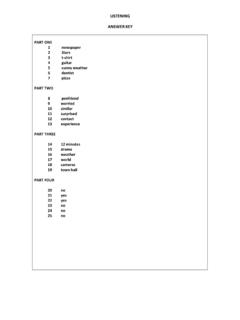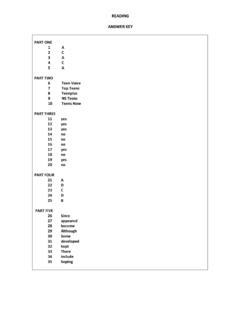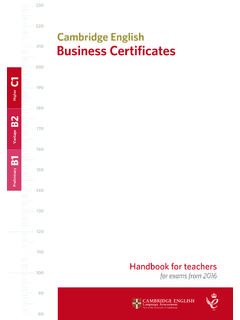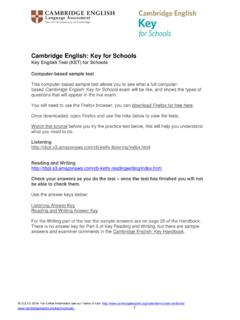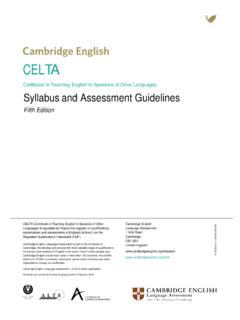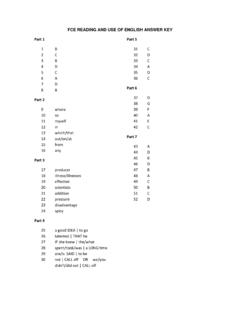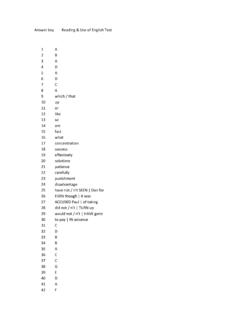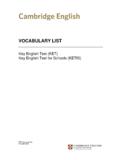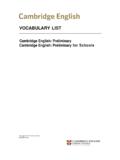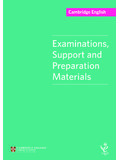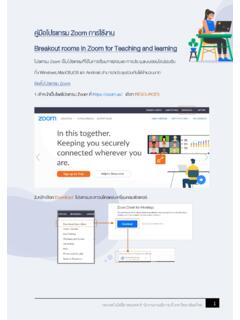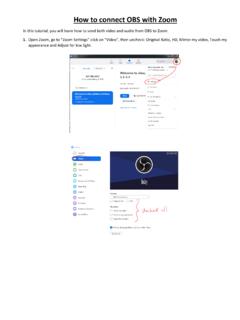Transcription of A2 Key for Schools Writing part 7 - Cambridge English
1 1 A2 Key for Schools Reading and Writing Part 7 Picture story Description This lesson plan has been created to help students prepare for A2 Key for Schools Reading and Writing Part 7. This lesson plan can be delivered face to face or online. The online options column gives teachers ideas about how the stages could be adapted for teaching online. In this lesson learners consider and discuss their home study environment and habits before planning and Writing a story on the same topic. By analysing a sample text, learners identify success criteria to support their own story Writing . Time required: 60 minutes Materials required: Images: Studying at home Handout 1: A broken computer Handout 2: A2 Key for Schools Writing Part 7 sample task Prepared presentation/PowerPoint slides Aims: To share ideas for creating a positive home learning environment To develop learners ability to develop a narrative and write about past events To familiarise learners with A2 Key for Schools Writing Part 7 To develop strategies for the A2 Key for Schools Writing Part 7.
2 Procedure Lesson Stages Online options Welcome students Welcome learners, prompt them to greet each other. Ask learners to say hello to confirm they can see and hear you. Lead in Ask learners to think about the following questions, then share their answers with a partner. Which subjects do you love (or hate) studying? Why? Where do you usually study? What helps you concentrate? How do you prepare yourself and your study area? Ask groups to share any common or interesting answers. Ask learners to share answers to questions in the chat. Ask a few learners with a microphone/interesting response to explain their ideas more fully. Setting the scene Split the class into two groups (A) & (B). Tell them they will look at one of two pictures (which are very similar). Learners should think about the following information: Who? Where? Add images to shared documents (googledoc for example). Share a link to each in the chat, telling individual learners which picture they should look at.
3 Ask learners to add their ideas (describing 2 What s happening? Why? Display the images at opposite ends of the classroom. Send one group to each image. Give learners individual thinking time before asking them to discuss their ideas in their ( ) and ( ) groups. Put learners into groups containing people who have looked at each picture (AABB). Ask learners to describe their pictures and identify: What s the same about the 2 pictures? What differences are there between the 2 pictures? Ask groups for their ideas about each picture; (Who? Where? What s happening? Why?). Allow all the learners to see both images. the pictures and the story they tell) below their image. If you are able to safely facilitate breakout rooms , use them to allow learners to speak and exchange ideas in groups. Otherwise nominate a speaker from each group (with a microphone) to summarise their group s ideas and attempt to identify the similarities and differences between the images.
4 Display both images using your whiteboard. Developing a narrative Explain that the images show the beginning and end of a very short story. Ask learners to discuss the following questions in their groups. Encourage them to be creative. Which image is the start of the story, which is the end? What may have happened in the middle? Give groups a sheet of paper, ask them to: draw a picture that links the first and last images. prepare to tell the story (explain the sequence of events and how they are connected). Ask groups to share their stories. Display examples using your whiteboard. Create and share a link to a Padlet wall. Ask learners to open a new post and with the draw tool, create their own picture that links the other two. Ask learners to add comment to their post, and briefly explain what is happening. Ask learners to look at their classmates pictures, asking them to comment and ask questions about them. For example: Who is that?
5 Where? What is happening? Why? Analysing an example Tell learners you wrote a story about the pictures. Give out Handout 1. Tell learners to read the story ignoring the gaps. Is it like any of theirs? Tell learners to look at the gaps. What kind of words are missing? (verbs). Ask learners to individually guess the missing words, then to check in pairs. Check answers encouraging learners to suggest alternative words that also fit the text (finished/did his homework). Ask learners which tense the story is in (past). Ask learners to circle any words that connect different actions, events or parts of the story ( when , so , and ). Tell learners that these are called conjunctions . Explain the task then display Handout 1 on your whiteboard. Read the story, pausing at each gap. When you pause, prompt learners to suggest words to fill the gap. 3 Success criteria Display the following questions and ask learners to note their answers: The story has ___ (41) words.
6 It describes what happens in ____ (3) pictures. The story uses ____ (past) verbs to describe what happened in each picture. The story uses _____ (conjunctions) to show the connections between different events, actions and parts of the story. There are _____ (lots) of possible answers, be creative! Check answers, highlighting that they do not need to write as many words in the exam (35 words+). Explain that this activity is similar to A2 Key for Schools Writing Part 7. Display the gap-fill sentences on your platform s whiteboard. Instruct learners to note the sentences before attempting to fill the gaps. Ask learners to share their completed sentences in the chat then confirm the correct answers. You do it Tell learners to write their stories (incorporating the picture they drew). They should tick the success criteria as they meet them. Tell students to swap texts with another student and give feedback. Have the success criteria been met?
7 Note a selection of examples of language use (some good, some featuring errors) while learners are Writing and checking. Try to collect examples of common errors (for example, use of conjunctions, use of past simple). Ask learners to draft their own stories, incorporating the picture they drew in the Padlet. Ask learners to check their stories meet the success criteria before editing (if necessary) and adding them as a comment to the Padlet. Encourage learners to read each other s stories, offering feedback (meanwhile note examples of language and create a poll for the next stage) Feedback Display a selection of examples of learner Writing . Ask learners to identify which sentences are OK, and which can be improved. Put learners in groups and ask them to discuss and explain their answers. Check answers as a whole class. Ask students to correct the remaining examples, before comparing and explaining their thinking with a partner. Check answers as a whole class ask learners to justify their answers.
8 If you are able to safely facilitate breakout rooms , use them to allow groups to speak and discuss which examples of learner Writing are correct/could be improved. Otherwise create a poll (for example, ) prompting learners to identify whether examples are OK, or contain specific errors. When checking answers, ask learners to explain the reasons for their ideas. Do it again Tell learners to draw a new final scene for their partner s story. Ask learners to rewrite their story, including their new picture. Tell students to check their Writing meets the success criteria. Ask learners to read the story to the right of theirs (on the Padlet). The learner with the final story, should read the first story. Ask learners to add comment and draw 4 Display learner stories and images on classroom walls. Encourage learners to read each other s stories, giving feedback on how interesting or funny they are. a new final scene to that story. Tell learners to rewrite their original story so it includes the new ending.
9 Ask learners to read each others stories and comment, saying which they liked and why. Exam practice (optional) Give Handout 2 to learners. Ask them to complete the exam task, referring to the success criteria. Ask learners to exchange stories and peer-correct, referring to the success criteria. After the lesson, share the exam task by putting it on a googledoc (together with the success criteria) and allocating a different page/area to each learner. 5 Materials Images Images from 6 Handout 1: A broken computer 7 Handout 2: A2 Key for Schools Writing Part 7 sample 8 Answers Handout 1 (possible answers) The student was doing homework when he knocked the computer onto the floor. The screen broke so he got a pen and ruler and finished his homework on his notepad instead. He got a good mark but still was not happy!
